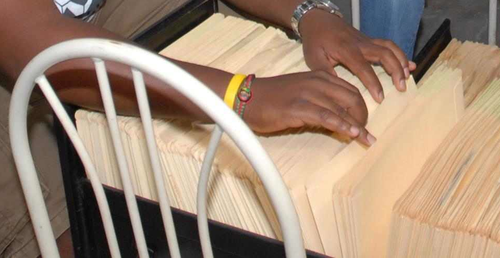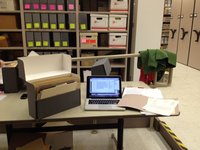The BMRC implemented a layer of protection against disruptive bot traffic. Learn more.
Processing Your Materials
Arrangement
How you arrange (organize) and describe (catalog) your collection will dictate how accessible your collection is to your audiences. Think about who will be interested in viewing or accessing your collection – is it just family members? Community members? Future researchers? Other individuals who are curious about you, your family, or your organization? Would you like all the above to use your collection? If you plan on eventually donating your materials to a repository like a museum or library, you can leave arrangement and description largely up to the archivists at that institution. They will try to keep to your original order of materials and keep that context intact for future viewers of the collection. They will also be responsible for creating a finding aid that will let people know what the collection is about, who created it, and what is documented within it.
On the other hand, if you plan on housing your collection on your own, arranging and describing it will help you keep track of where specific materials are and help visitors decide what to ask for when visiting your holdings, if you make that access available.

- Physical storage groupings of archival materials are often in categories of similar media or format such as correspondence, photographs, diaries/scrapbooks, certificates, posters, or other documents. If there are different types of material in the collection, they should be grouped together in similar containers to ensure proper storage. For example, photographs should go with other photographs in proper sleeves or envelopes, manuscript papers should go with other papers in folders, etc. See more information about which housing materials you can purchase on our Starting Your Archives: Supply List spreadsheet.
- Materials can be organized within those groupings in chronological, reverse chronological, or alphabetical order. Which of these orders best fits your collection is up to you. If many of your photographs have dates on them, then chronological or reverse chronological order makes sense. If you have undated letters that are all addressed with names, then alphabetical order by name or location could make more sense.
- You should group materials without dates or names together and try to find another grouping within that to categorize them. You can also try to estimate the date – for example with photographs, often the background, kind of photo, or the clothes people are wearing in it can indicate the time period the photograph is from.
- Arrangement for materials stored digitally will likely be similar to groupings for analog materials, though there are some differences. Learn more about personal digital archiving by watching Part Two of our Introduction to Archiving Series.
Once items have been grouped together and put in the proper order, you can begin cataloging and describing your collection.
Description
You can either choose to create a general catalog or inventory of items in your collection, or a thorough finding aid. Finding aids provide more context about your collections such as:
- who created it (Biographical Note),
- a summary of the collection (Abstract),
- which materials are most prominent in the collection (Scope and Content Note),
- and how the collection can be accessed or used (Information on Use).
An example of an annotated finding aid can be found on the Society for American Archivist’s website. Finding aids organize lists of materials into sections of series, sub-series, boxes, folders, and items. The series and sub-series could be decided by the physical groupings of materials for storage mentioned before, but the description in your finding aid, or intellectual organization, does not necessarily have to match the physical organization used for storage. For example, although photographs might be stored together for preservation purposes, they might be listed in the finding aid as part of a different series along with the letters they were originally in envelopes with. In other words, materials stored in the same location might be listed in different series if they are relevant in different contexts.
Your finding aid should have an inventory of your holdings within these series’ and sub-series' and should include:
- the box or volume numbers,
- a title for the box clearly stating what it contains,
- the number of boxes or volumes within that series or sub-series,
- a summary of the contents,
- dates associated with the contents or a specification that they are undated,
- and any other important notes about the items, including preservation notes (i.e., if a folder holds particularly fragile or at-risk materials).
If you prefer not to or do not have the capacity to provide such a specific description of your collection, you can also create a collection-level description that covers the general scope of the materials. This should include a description of when, why, and by whom the collection was created and a general inventory or summarized list of what is found in the collection. Whether the finding aid you make is thorough or not, it is important for people viewing your collection to be able to know what materials are in it and the terms on which they can access them. This is so that viewers can decide whether your collection is relevant to their question and, if so, which items to ask for when planning a visit.
Digital materials must also be described properly if they are to be discoverable by your audiences. Learn more about describing digital collections by watching Part Two of our Introduction to Archiving Series.
Once your collection has been processed, you can begin providing access to your materials.
This resource was first created by Jehoiada Calvin (f.k.a. T Calvin), BMRC Community Engagement Archivist, in 2020, and edited by him in 2022.
